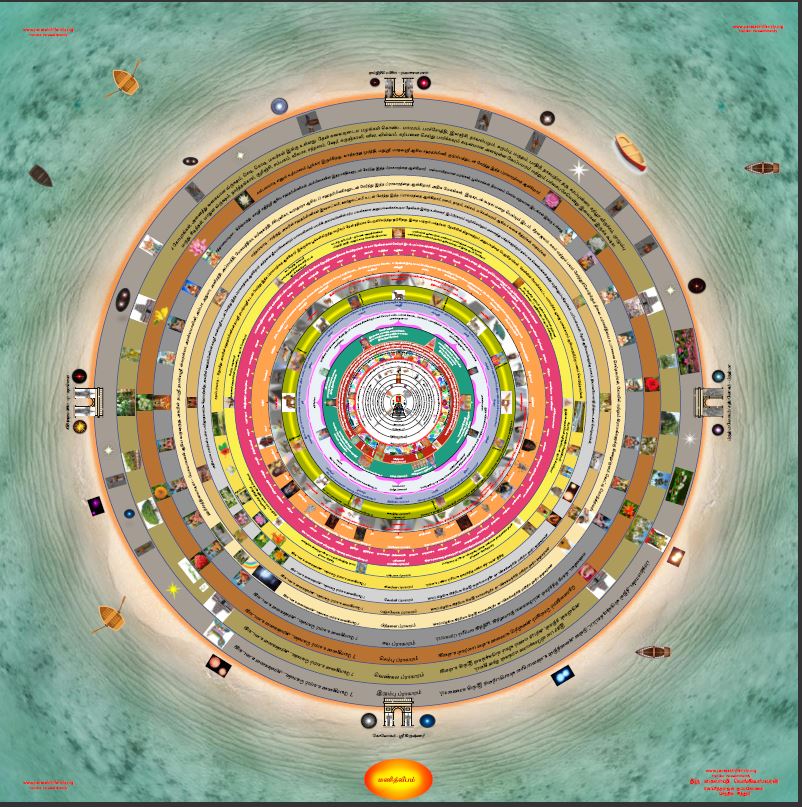NARADHA BHAKTHI SUTHRAM – TAMIL UPANYASAM – SEP-25-2020 : Episode 32
28/04/2021
Om Namasivaya Nama:
Narada Bakthi Suthram – Chapter 05 – Bakthi Mahima:
This chapter deals with the importance of devotion and devotees!
Sutram 80:
Sa Keerthyamaanaha seegramevaavirbhavathi Anubhaavayathi Cha Bakthaan!
Sa = That God, Keerthyamaanaha = When praised and worshipped, seegramevaavirbhavathi = Immediately appeared in front of, Anubhaavayathi = felt his presence, Cha Bakthaan = near devotees.
Meaning: When devotees continuously praised or worshipped, God immediately appears in front of them and bless them with realization. Not only that he makes devotees as his relative or Mithran (Friend) and involve them in his divine plays. God shows his presence among devotees as per their desired form. God is not far from his devotees, one must pray sincerely to feel his presence at any time anywhere.
God is not even expecting the devotee to be hundred per cent perfect, the mode of devotion can vary from Kaama, Krodha, Bhaya, Sneha, Sakhyam and Souhrudham. Continues prayer’s result is nothing other than reaching God’s abode. Many examples are seen in his life stories. God is also rewarding them Salokhya and Saroopya Mukthi for them. Why can’t we try it and see in person? This biggest freedom is given to devotees in our Sanadhana Dharma, no other religion or cult will allow to experiment or cross-question their scriptural verdicts.
Sutram 81:
Thrisathyasya Bakthireva Gareeyasee Bakthireva Gareeyasee!
Thrisathyasya = For all the three divisions of time, Bakthireva = Devotion alone, Gareeyasee = Preferable or Supreme.
Meaning: At all times i.e. past-present and future devotion alone is the most preferred choice to realize God when compare with other paths such as Karma, Ghyaana and Yoga. One should be lucky to be a genuine devotee with whom God converse as a friend or relative. All realized personalities jointly agreeing to that, the simple and easiest route for realization God is devotion path. Devotional path not only great during Sadhana (seeking or practising period) but also a great path even after Saadhya/Sidha (realized/accomplished) time. God is a relative among devotees and vice versa, wow, what a status God is giving to his devotees! One should grab this opportunity without wasting time.
Therefore Sage Narada repeating again and again that devotion alone is the ultimate path to realize God and achieve Godhood!
Sutram 82:
GunamAhAthmya-Sakthi, Roopa-Sakthi, PoojA-Sakthi, SmaraNA-Sakthi, DhAsyA-Sakthi, Sakhya-Sakthi, VAthsaylA-Sakthi, KAnthA-Sakthi, AthmanivedhanA-Sakthi, ThanmayA-Sakthi, ParamavirahA-Sakthi, RoopA Eakadha Api EakadhasadhA Bhavathi !
GunamAhAthmya-Sakthi = Interest or attachment to the glorification of blessed qualities of God, Roopa-Sakthi = Attachment to God’s beautiful forms, PoojA-Sakthi = Attachment to his worship, SmaraNA-Sakthi = Attachment to his remembrance, DhAsyA-Sakthi = Attachment to his service, Sakhya-Sakthi = Attachment to his friendship, VAthsaylA-Sakthi = Attachment to his filial love to him, KAnthA-Sakthi = Attachment to his consort like love for him, AthmanivedhanA-Sakthi = Attachment to Self-Surrender, ThanmayA-Sakthi = Attachment to being filled/merged with him, ParamavirahA-Sakthi = Attachment to an intense feeling of the excruciating pain of separation from Him, RoopA Eakadha = Though it is one, Api EakadhasadhA Bhavathi = Manifested in eleven types.
Meaning: Though the Bakti itself only one but it manifests in different ways and forms, preferably eleven types according to Sage Narada. Just simple innocent unconditional love continuously flows towards God is called Bakthi. There is no pre-requisite qualifications are needed to practice Bakthi. It is applicable to all human race. How many types of devotees are there that many types of devotional paths exist. God welcomes all practices. Due to the inbound nature of individual devotees, their approaches to God also differ. Great and realized devotees club those practices under 3, 5, 9 and 11 types. According to Sage Kapila devotion is classified into three division such as SAthweekam, Raajasam and ThAmasam. Realized devotee Chaithanya classified into 5 types such as Santham, DhAsyam, Sakhyam, VAthsalyam and Madhuram. According to realised devotee Prahlaadha, it is classified into 9 types such as sravanam, keerthnam, Smaranam, PAdhasevanam, Archanam, Vandhanam, DhAsyam, Sakhyam and Aathmanivedhanam. According to Sage Narada it is 11 types such as sravanam, keerthnam, Smaranam, PAdhasevanam, Archanam, Vandhanam, DhAsyam, Sakhyam and Aathmanivedhanam, Thanmayam and Paramaviraham.
Examples of those 11 types Bakthis and its Heros are:
GunamAhAthmya-Sakthi = Narada and Vyasa, Roopa-Sakthi = Devotees of Vrindavan, PoojA-Sakthi = Ambarishan and Prudhu, SmaraNA-Sakthi = Prahladan, DhAsyA-Sakthi = Hanuman, Sakhya-Sakthi = Udhava and Arjuna, VAthsaylA-Sakthi = Yasodha and Kausalya, KAnthA-Sakthi = Rukmini, Sathyabhama and other consorts, AthmanivedhanA-Sakthi = Mahabali and Vibhishana, ThanmayA-Sakthi = Sanaka-Sananda-Sanathana-Sanathkumar, ParamavirahA-Sakthi = Gopikaas.
Sivoham… To be continued…
You may watch full discourse from the link:
Have any Question or Comment?
Links
Sree Lalitha Sahasranama Namavali Meaning (Tamil)
ŚRĪMAD DEVI BHĀGAVATAM -Tamil Upanyasam
VIVEKACHUDAMANI – Tamil Upanyasam
The Thiru Kural – Tamil Pravachan
Periya Puranam – Tamil Pravachan
Ammavasai Tharpanam_Tamil Meaning & Procedure
Srimad Bhagavad Gita – Malayalam Pravachan
Srimad Bhagavad Gita Recitation
Sriman Narayaneeyam Recitation and Meaning
SAKTHI CHAITHANYAM

Violet Aura on Devi Chaithanyam

Great Holy Kailas Parvath

Recent Posts
- SOUNDARYA LAHARI SLOKAS MERITS AND REWARDS
- BHOOTHA-PRETHA-PISACH – REAL? – EP-08 – FINAL (TAMIL) – BY R V VENKITESWARAN
- BHOOTHA-PRETHA-PISACH – REAL? – EP-07 (TAMIL) – BY R V VENKITESWARAN
- BHOOTHA-PRETHA-PISACH – REAL? – EP-06 (TAMIL) – BY R V VENKITESWARAN
- BHOOTHA-PRETHA-PISACH – REAL? – EP-05 (TAMIL) – BY R V VENKITESWARAN


